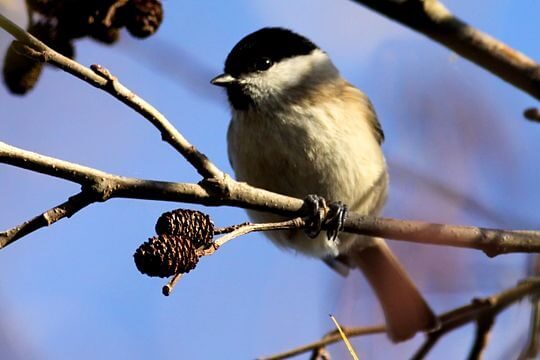
For over two decades, Richard Broughton has delved into the intricate lives of marsh tits in Monks Wood, a serene ancient woodland nestled in Cambridgeshire. Unlike a city neighbourhood watch, Broughton’s subjects are the feathered inhabitants of the forest. “They used to have a big punch up in spring here,” he says, pointing out where one family’s territory ends and the next begins.
“I always get a bit of a pang now, walking through here and it’s empty. It’s like walking down your local high street and seeing your favourite shops are closed and the pub is boarded up.”
These tiny songbirds, each barely weighing as much as two sheets of A4 paper, have become the focus of his prolonged scientific study.
Armed with an old Nokia phone, Broughton plays recorded bird calls to attract the attention of a particularly notable marsh tit, who at nine years old, shows the vigour of a bird half his age. Upon hearing the alarm call, the bird investigates the source, showcasing the species’ characteristic boldness and territorial nature. These birds, identifiable by their black caps and distinctive markings reminiscent of Inspector Clouseau’s moustache, are quick to respond to perceived threats in their territory.
However, the vibrant life in this woodland masks a grim reality. The UK has seen a staggering decline in bird populations, with over 70 million birds vanishing since 1970. Songbirds like the marsh tits are among the hardest hit, their melodic calls increasingly drowned out by human activity and their numbers plummeting due to a variety of environmental pressures.
Broughton, an expert from the UK Centre for Ecology and Hydrology, has been meticulously studying this particular family of marsh tits, marking over 1,600 individuals with coloured bands to monitor their populations over the years. Unfortunately, only a tiny fraction of these birds survive today. What began as a robust community of 22 pairs has dwindled to fewer than ten in recent years, reflecting a broader national decline of 80% in the breeding population over the last 55 years.
Projections now grimly forecast their potential disappearance by 2042.
“We know what’s coming. Within my lifetime they will probably disappear. It can be distressing to watch because you get to know their lives and relationships,” says Broughton.
The causes of this decline are multifaceted. Increased competition from blue tits and great tits, which adapt more readily to human-altered environments by foraging in garden feeders—a practice marsh tits do not engage in—has put additional pressure on the species. Furthermore, the critical timing of their food sources, such as hawthorn-dwelling caterpillars, has been disrupted by climate change, leaving the birds ill-prepared for breeding season.
Compounding these challenges, the woodland that serves as their habitat is encircled by intensively farmed land. Marsh tits, reluctant to cross open fields, find themselves increasingly isolated and confined to shrinking patches of suitable habitat. This isolation has led to inbreeding and further vulnerability.
The decline in marsh tit populations in Monks Wood is symptomatic of a broader crisis affecting woodland birds across the UK, with a 37% average decrease in numbers since 1970.
“These birds are telling us that something serious is happening in the woods,” says Broughton.
Broughton’s long-term study not only sheds light on the marsh tits but also reflects the larger ecological shifts threatening biodiversity. When he first came to the wood in 1999 there were nightingales, willow tits, hawfinches and lesser-spotted woodpeckers – birds that had been here for hundreds or thousands of years.
“Now they’ve all gone,” he says. “Marsh tits will probably be next.” The removal of hedges, woodlands and increased numbers of deer are all reducing the size and quality of their habitats.
As Broughton reflects on his years in the woodland, he recounts tales of individual birds whose lives and losses have intertwined with his own research journey. In one 12-acre section of wood is an old male’s entire universe; he’s probably never left it, and knows it inside-out, right down to every tree and shrub. Over winter he will hide tens of thousands of seeds, a bit like a squirrel.
“If they’re not on their territory they’re dead,” says Broughton. In that sense, they’re easy to monitor.
Nearby, a pair of marsh tits remained inseparable for eight years until the female vanished, leaving her partner visibly distressed.
“It brought a lump to my throat,” says Broughton. The male appeared bereft, and didn’t pair up with the available females around him. Two months later he died too.
These personal stories highlight the emotional impact of witnessing the slow demise of a species. For Broughton, Monks Wood is filled with memories of bird families and nests now gone, a living archive of both the resilience and fragility of nature.
“There is an emotional toll. I can’t feel neutral about it, I can’t just treat them as datapoints,” he says. “It’s my own ‘silent spring’.”
——————————————————————————
At Natural World Fund, we are passionate about stopping the decline in our wildlife.
The decline in our wildlife is shocking and frightening. Without much more support, many of the animals we know and love will continue in their decline towards extinction.
When you help to restore a patch of degraded land through rewilding to forests, meadows, or wetlands, you have a massive impact on the biodiversity at a local level. You give animals a home and food that they otherwise would not have had, and it has a positive snowball effect on the food chain.
We are convinced that this is much better for the UK than growing lots of fast-growing coniferous trees, solely to remove carbon, that don’t actually help our animals to thrive.
This is why we stand for restoring nature in the UK through responsible rewilding. For us, it is the right thing to do. Let’s do what’s right for nature!
Donate today at https://naturalworldfund.com/ and join in the solution!

